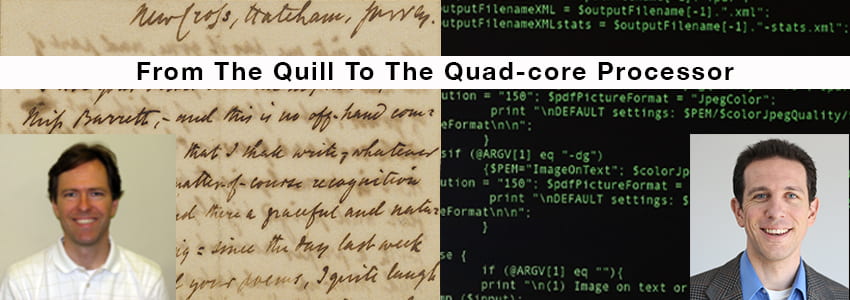
Professors William Weaver, PhD (left) and Greg Hamerly, PhD (right) secured grant funding to study the love letters of Robert and Elizabeth Barrett Browning using computer algorithms. Their project will get underway this summer.
In a year filled with firsts for the Digital Projects Group, we’re excited to announce another. Two Baylor University faculty members – Dr. Greg Hamerly (Associate Professor, Computer Science) and Dr. William Weaver (Assistant Professor, Great Texts Program – Honors College) – shared the news with this week that they had received a URC grant for a joint project entitled “Critical Soliloquies: A Project of Electronic Discovery in the Browning Love Letters.” This project is the first-known research project based on items from one of our Digital Collections to receive grant funding, and it all centers on one of our most well-received collections.
The project is an ambitious blend of rhetorical evaluation and computer science, a combination that is a perfect fit for the digitized Victorian-era letters available via the Browning Letters Project. Dr. Weaver shared the abstract from the proposal, which describes the research project thusly:
For over a century, from their first publication in 1899, the love letters of Victorian poets Elizabeth Barrett and Robert Browning have won the hearts of readers. A near complete record of the poets’ courtship from 1845 to 1846, these letters include a substantial body of literary criticism. This criticism includes their assessments of each other’s works in progress and the works of major contemporary figures like Carlyle, Tennyson, and George Sand, not to mention numerous minor artists of the Victorian era. It would be possible and interesting, using transcribed editions of the letters, to excerpt and collect these critical writings.
This interdisciplinary project, between literary studies and computer science, attempts something more ambitious. Building on Baylor Library’s recent digitization of the 574 letters (published on Valentine’s Day 2012), we will create a database of critical and non-critical writing from the letters. Using tools for text classification, we will then test whether a computer can make reliable discriminations between the two classes of text. Such a tool could be extended to discover “critical soliloquies” (Elizabeth Barrett’s term) in this and other Victorian archives.
If using computer-based tools to analyze 19th century missives sounds like the ultimate steampunk/sci-fi fan fiction, you wouldn’t be too far from the truth. And no pair of researchers is better suited to tackle the task than professors Weaver and Hamerly, two men with great skill and expertise in two very different – but strangely complementary – areas of interest.
The Origins of Our Involvement
Weaver and Hamerly approached us about a year ago with the idea of using one of our digitized collections to perform computer-based evaluation of materials that were written by hand or set in type before the advent of computers. After a meeting with myself and Darryl Stuhr, Assistant Director for Digital Projects, we enthusiastically agreed to provide access to any digital assets that the professors might need to carry out their work.
For us, it was a natural fit between the wealth of information to be found in archival materials and the power and accuracy of evaluation performed by computers. And once the Browning Letters Project went online in February 2012, the opportunity to analyze the love story of Robert and Elizabeth Barrett Browning proved too good to pass up.
What’s Next?
Dr. Weaver informs us that the first step is to assign students the task of creating a database and begin assigning annotations to the letters. He hopes to see this phase one of the project get underway in June. Successive steps would include the creation of the computer algorithms and processes for analyzing the data input by the students in phase one.
This cross-departmental, multi-discipline approach is the kind of research being conducted at universities across the country, where experts in several fields find new ways to play off each others’ strengths in pursuit of a new, shared goal. In this case, it is the quest to see if a computer can match a human’s critical analysis and evaluation of the written word. Will the machine find these distinctions between the “critical and non-critical writing,” or will it prove to elude even our most up-to-date technology? Will computer science open new doors in the rhetorical examination of our analogue past? And can the application of computing power make it easier for our scholars to delve deeper into the minds (and hearts) of two of Western culture’s greatest creators?
Stay tuned to this blog for updates!
For more information on Dr. Weaver’s work in the Baylor Great Texts program, visit his website. For more information on Dr. Hamerly and his work in Computer Science research, visit this website.
